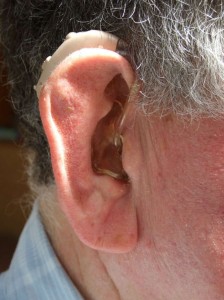How Much Does a Hearing Aid Cost?
Hearing Aid Cost & Price Summary
Every year, thousands of people purchase hearing aids. While some are replacing their existing aids, there are many who are purchasing their first pair. While most hearing aids have similar features, prices can vary from $1,800 to $6,800 per pair according to ConsumerReports.org, with the average cost being approximately $4,500 per pair. The lowest prices found are $1,200 per pair for a simple hearing aid with no additional features.

Types of Hearing Aids
There are five major types of hearing aids. Each one has its own unique benefits and disadvantages.
Behind the Ear Open Fit
This type of behind the ear aid is extremely comfortable and barely noticeable to others. Many hearing aids make the ears feel “plugged up” according to users, but this type, because of its style, minimizes this feeling. This type may not require a telecoil (see features below). However, sweat can easily cause malfunctions to this type of unit and has limited manual controls. Prices range from $1,850 to $2,700 per aid.
Behind the Ear with Earmold
This is the most versatile and reliable of all hearing aids because it assists with all types of hearing loss. It is, however, the most visible and is susceptible to damage from sweat and earwax. Many users complain of the “plugged up” feeling unless the earmold is vented (see features below). These tend to be the most economical at $1,200 to $2,700 per aid.
Completely in Canal
These are practically invisible and do not require any additional features to reduce telephone noise. They do have a short battery life and can be damaged by earwax and moisture. They also cause the “plugged up” feeling. These are the most expensive at $1,365 to $2,860 per aid.
In the Canal
These are nearly identical to the Completely in Canal aids, but the disadvantages are less pronounced. They are also a bit less expensive at $1,300 to $2,750 per aid.
In the Ear
These types of hearing aids have more room for features such as manual volume control and give the user less of the “plugged up” feeling. These are the most visible of the “in the ear” models and are at risk of being damaged by water and earwax. Prices range from $1,200 to $2,700.
Hearing Aid Features
The vast majority of hearing aids have these standard features.
- Digital noise reduction which decreases annoying background noises in most, but not all, environments.
- Low battery indicator.
- Power on delay which prevents the feedback “squeal” when inserting the device.
- Wax guard to help keep the aids free from earwax buildup. Earwax buildup is the major complaint of users and is the culprit behind many malfunctions.
- Automatic volume control or compression allows for more amplification in environments with low sounds and less in high sound environments.
- Vents are tiny tunnels in earmolds that help diminish the “plugged up” sensation.
- Manual volume control.
- Telecoils amplify sound from phones without picking up background noise.
- Directional microphones help users understand conversation in noisy environments. These are not be available on the Completely in Canal or In the Canal aids since these devices are often too small to accommodate this feature.
- Feedback suppression reduces the “squeal” when the aid gets too close to a phone or the earmold is not fitted properly.
- Direct audio input allows behind the ear models to be connected to MP3 or other audio devices.
- Bluetooth capability is also available for behind the ear models to allow hands free use of cell phones.
The choice of a hearing aid depends on many factors, such as lifestyle, degree of hearing loss and amount of visibility of the unit. As these devices continue to become more technologically advanced, users will find they are able to find the right device to fit both their needs and their budget.
Popular Hearing Aid Brands:
- Oticon
- Phonak
- ReSound
- Siemens
- Sonic
- Starkey
- Unitron
- Widex


 Posted under:
Posted under: